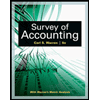
1.
Introduction: The transfer price refers to the price at which the goods and services are exchanged between companies under common control or between divisions of the same company.
The value of the lowest acceptable transfer price for the selling division, the highest acceptable transfer price for the buying division, the range of acceptable transfer price and will the managers voluntarily agree to transfer the units along with the reasons for the same.
2.
Introduction: The transfer price refers to the price at which the goods and services are exchanged between companies under common control or between divisions of the same company.
To explain: The effect on the profits of the P Division, C division, and the entire company due to the change in the supply price of the P division.
3.
Introduction: The transfer price refers to the price at which the goods and services are exchanged between companies under common control or between divisions of the same company.
The value of the lowest acceptable transfer price for the selling division, the highest acceptable transfer price for the buying division, the range of acceptable transfer prices and will the managers voluntarily agree to transfer units within the divisions along with the reason for the same.
4.
Introduction: The transfer price is the price that is charged by one department of the company to another department of the same company for the transfer of goods and services.
The P Division should meet the price of the outside supplier or not.
The effect on the profits of the company as a whole when the P Division does not meet the price of the outside supplier.
5.
Introduction: The transfer price is the price that is charged by one department of the company to another department of the same company for the transfer of goods and services.
Whether the C Division should purchase from the P Division at a higher price for the good of the company as a whole.
6.
Introduction: The transfer price is the price that is charged by one department of the company to another department of the same company for the transfer of goods and services.
The effect on the profits of the company as a whole when the C Division is required to purchase 5,000 tons of pulp each year from the P Division at $70 per ton.
Want to see the full answer?
Check out a sample textbook solution
Chapter 11 Solutions
MANAGERIAL ACCOUNTING FOR MANAGERS EBOOK
- I have assignment this 3 Question please Solve It for mearrow_forwardPharoah Street Inc. makes unfinished bookcases that it sells for $59. Production costs are $38 variable and $10 fixed. Because it has unused capacity, Pharoah Street is considering finishing the bookcases and selling them for $73. Variable finishing costs are expected to be $6 per unit with no increase in fixed costs. Prepare an analysis on a per unit basis showing whether Pharoah Street should sell unfinished or finished bookcases. (Enter negative amounts using either a negative sign preceding the number e.g. -45 or parentheses e.g. (45).) Sell Sales price per unit $ $ Cost per unit Variable Fixed Total Process Further Net Income Increase (Decrease) $ Net income per unit $ $ $ The bookcasesarrow_forwardPlease Provide Solution Of this Accounting Question Need Answer For All Questionsarrow_forward
- These transactions took place for Blossom Co. 2024 May 1 Received a $3,000, 12-month, 4% note in exchange for an outstanding account receivable from R. Stoney. Accrued interest revenue on the R. Stoney note. Dec. 31 2025 May 1 Received principal plus interest on the R. Stoney note. (No interest has been accrued since December 31, 2024.) Record the transactions in the general journal. The company does not make entries to accrue interest except at December 31. (List all debit entries before credit entries. Credit account titles are automatically indented when amount is entered. Do not indent manually. Record journal entries in the order presented in the problem. If no entry is required, select "No Entry" for the account titles and enter O for the amount in the relevant debit OR credit box. Entering zero in ALL boxes will result in the question being marked incorrect.) Date Account Titles and Explanation Debit Creditarrow_forwardOriole Co. has the following transactions related to notes receivable during the last 2 months of the year. The company does not make entries to accrue interest except at December 31. Nov. 1 Loaned $54,600 cash to C. Bohr on a 12-month, 8% note. Dec. 11 Sold goods to K. R. Pine, Inc., receiving a $1,800, 90-day, 7% note. Received a $14,400, 180-day, 6% note to settle an open account from A. Murdock. 16 31 Accrued interest revenue on all notes receivable. Journalize the transactions for Oriole Co. (Omit cost of goods sold entries.) (List all debit entries before credit entries. Credit account titles are automatically indented when amount is entered. Do not indent manually. Record journal entries in the order presented in the problem. Use 360 days for calculation. If no entry is required, select "No Entry" for the account titles and enter O for the amount in the relevant debit OR credit box. Entering zero in ALL boxes will result in the question being marked incorrect.) Date Account…arrow_forwardHello tutor please given general accounting question answer do fast and properly explain all answerarrow_forward
 Survey of Accounting (Accounting I)AccountingISBN:9781305961883Author:Carl WarrenPublisher:Cengage Learning
Survey of Accounting (Accounting I)AccountingISBN:9781305961883Author:Carl WarrenPublisher:Cengage Learning
